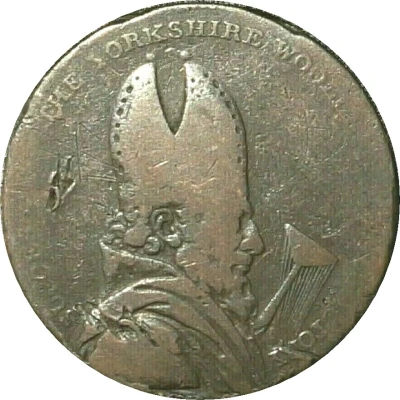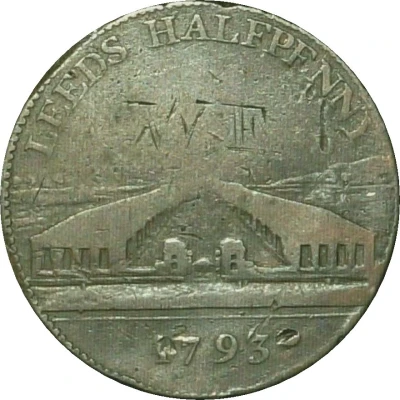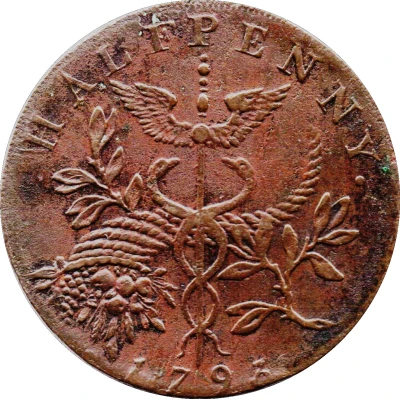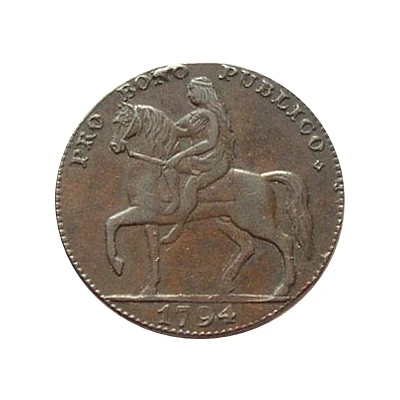


½ Penny - Leeds halfpenny H. Brownbills
1793 year| Copper | 11.33 g | 28.75 mm |
| Issuer | United Kingdom (United Kingdom, British Overseas Territories and Crown Dependencies) |
|---|---|
| Type | Token |
| Year | 1793 |
| Value | ½ Penny (1⁄480) |
| Currency | Conder tokens (1787-1797) |
| Composition | Copper |
| Weight | 11.33 g |
| Diameter | 28.75 mm |
| Thickness | 2.2 mm |
| Shape | Round |
| Technique | Milled |
| Orientation | Medal alignment ↑↑ |
| Demonetized | Yes |
| Updated | 2024-10-09 |
| Numista | N#235149 |
|---|---|
| Rarity index | 91% |
Reverse
Aerial long perspective exterior view of large building with columns (Leeds Cloth Hall), with other houses in the distance and a hill on right. Lettering around, date in exergue, beaded border.
countermark WF
Script: Latin
Lettering:
LEEDS HALFPENNY
WF
1793
Edge
Plain with lettering
Lettering: PAYABLE AT H. BROWNBILLS
Comment
In Great Britain, a shortage of small denomination coinage had been reported as early as the late 14th century. Such a shortage made it difficult for workers to be paid, and for transactions of daily life to be carried out. The shortages persisted and worsened through the late 17th century and became particularly problematic by the middle of the 18th century. For many years, no copper or silver coins were minted at all, and in 1775 King George III had halted the production of copper coinage at the Royal Mint.Conder tokens, also known as 18th-century provincial tokens, a form of privately minted token coinage were struck and used during the latter part of the 18th century and the early part of the 19th century in England, Anglesey and Wales, Scotland, and Ireland. Conder tokens are named after James Conder who was an early collector and cataloger of these tokens.
Because Conder tokens were minted independently of government, the creators of these tokens had the freedom to make political statements and social commentary, to honor great men, ideals, great events, or to simply advertise their businesses. Subjects range from Isaac Newton to Abolition, Prisons and Mental Institutions to circus performers. Issuers of the coins needed only have the means and the will to mint their own coin. Many tokens were officially payable only in certain areas and locations, but there is no doubt that these copper promissory tokens were treated as official copper coin by many at the time and they circulated widely.
By 1795, there were thousands of different designs circulating, the great majority of these tokens being halfpennies. This particular ones was issued by Henry Brownbills Watch-maker and silversmith, Leeds (Yorkshire) copper Conder halfpenny token dated 1793.
The reverse of this token is considered one of the best works in perspective in the entire Conder series.
Bishop Blaize is the patron saint of woolcombers.
Interesting fact
The Leeds halfpenny token, issued in 1793, was used as a form of currency in the United Kingdom during a time when there was a shortage of official coins. It was made of copper and weighed 11.33 grams. Despite being a token, it was widely accepted as a form of payment and was used in many transactions. This token is a unique piece of history that highlights the resourcefulness and resilience of the people during a time of economic hardship.



